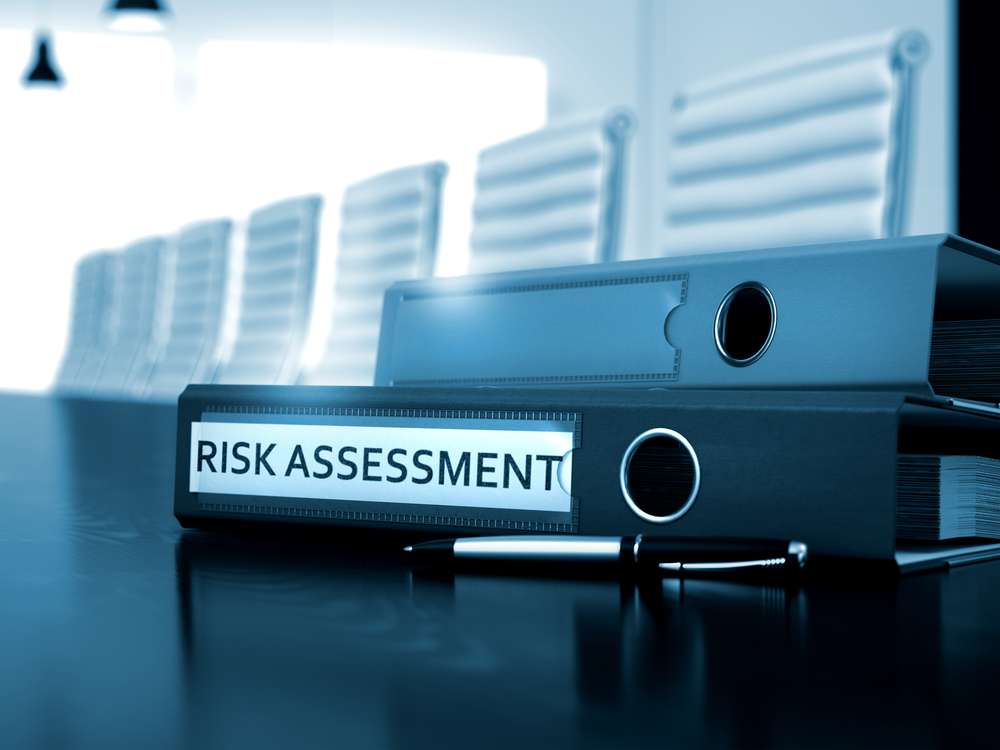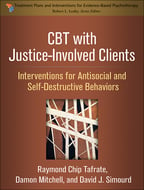
What works and doesn’t work when using Cognitive-behavioral therapy (CBT)? This is something the authors, Raymond Chip Tafrate, PhD, Damon Mitchell, PhD, & David J. Simourd, PhD, of this blog series have spent a long time studying and have put all they’ve learned in the book: CBT with Justice-Involved Clients: Interventions for antisocial and self-destructive behaviors. We thought our subscribers would be interested in a blog series on this content, knowing so many use or refer their clients to this type of treatment. Therefore, we are pleased to announce this blog series on Adapting CBT for Justice-Involved Clients.
Let’s face it, much of what occurs in criminal justice is negative. Justice-involved clients (JICs) commit crimes that challenge our sense of right and wrong and safety in the world. They also might resist supervision and intervention that is mandated to them by the courts. These and other issues can create a negative bias against JICs and their ability to improve themselves. Additionally, the contemporary models of rehabilitation are based on risk reduction and risk models that get a bad rap. It can be common for community corrections officers and case managers to be reluctant to embrace a risk reduction perspective with JICs because it is viewed as intrinsically pessimistic and deficit-driven. Practitioners often say that working from a risk framework emphasizes client failures and problems, and the assessment process is simply a matter of adding up the number of risks a client has amassed. By extension, intervention is seen as establishing a set of avoidance goals based on those factors such as stay away from criminal companions and stop smoking pot. The reality is that risk-based models, when used effectively, offer a constructive perspective on client functioning, much more than just a checklist of JICs’ shortcomings. A shift towards a different, more multifaceted way of thinking about risk is often required to make these models useful for practitioners. We also suggest that risk models are the strategic heart of effective community corrections work.
To be comfortable with risk-based models, we need to attend to good science (which very much exists in forensic work). The most important finding over the last decade is that better outcomes, in terms of reduced re-offending, occur when a risk-reduction perspective is used. Focusing on a review of court-mandated supervision conditions, mental health symptoms, or conducting drive through probation (three to four-minute cursory check-ins; “Any new arrests? Change of address?”) are not helpful. The good news is that most people are familiar with the philosophy of a risk-reduction approach because it occurs in other common life spheres such as heart disease (e.g., family history of heart disease, high cholesterol, smoking, diabetes, hypertension, obesity, poor diet, increased age, lack of physical activity). A risk-reduction approach to heart disease can be likened to going through life with a shopping cart; the more factors in the cart, the more risk. In terms of intervention, the goal is to remove those factors from the cart, fill it with healthier options, and avoid putting more risk into the cart in the future -- reducing a person’s risk profile as much as possible. The exact same risk-reduction approach applies to criminal behavior, but the items in the shopping cart are different.
Big Life Domains, Not Simplistic Factors
Much of the assessment and rehabilitation work conducted with forensic clients around the world is based on two main concepts: Risk-Need-Responsivity (RNR) and the “Central Eight” risk domains. Although the Central Eight are commonly referred to as risk factors (or criminogenic needs), for case planning purposes they are better conceptualized as risk domains. The term risk factor implies a single characteristic about a person that is linked with a negative outcome (e.g., high cholesterol is a risk factor for heart disease), whereas each of the Central Eight encompasses the JIC’s history, thinking, and behavior in a broad life area. Our recommended constellation of criminal risk domains to focus on (listed below) is built around the Central 8, although we have made several modifications:
- Prior criminal/antisocial behavior: Nature and extent of the antisocial conduct over the course of life.
- Criminogenic thinking/antisocial orientation: We use this combined term to capture the attitudes, beliefs and maladaptive thinking styles, as well as feelings, behaviors, and ways of interacting with others that underlie personality pathology linked to the antisocial construct. In cognitive-behavioral therapy (CBT) traditions, thinking is an integral part of personality disorders, so we do not separate thinking from antisociality.
- Antisocial companions: Connection with people involved in, or oriented toward, criminality; absence of prosocial friends.
- Dysfunctional family/romantic relationships: Family or marital/couple relationships that are emotionally detached and/or ignore, reinforce, or model antisocial behavior.
- Lack of connection to work/school: Lack of success/negative attitudes/low levels of performance and satisfaction related to work/school.
- Maladaptive leisure time: Aimless use of leisure time/lack of structure to daily routines; low levels of involvement in positive prosocial pursuits; enjoyment of antisocial and risky activities.
- Substance abuse/misuse: Misuse of alcohol and/or other drugs (including prescription medications).
- Anger dysregulation: Inability to modulate anger (e.g., frequency, intensity, and/or expression); anger reactions that create social, vocational, or interpersonal difficulties. We have also included anger dysregulation as an additional risk domain to be considered in treatment because anger difficulties are common in forensic populations and anger is the emotional excess most likely to be connected to re-arrest. (Admittedly, there is some debate about whether anger is best viewed as a mental health issue or criminal risk domain.)
Having an in-depth understanding of JICs’ functioning in these life domains, rather than a list of factors to be hastily checked off on a list, is at the heart of a practical and individually tailored supervision and case management strategy. Risk-based approaches are fundamentally postive in outlook (because risk profiles are changeable for the better) and interventions are solution-focused. More on the nature of risk-based approaches to supervision and case management will be highlighted in the next blog in this series.
* list of risk-domains adapted from: CBT with justice-involved clients: Interventions for antisocial and self-destructive behaviors
 The trajectory of the science and practice of cognitive-behavioral therapy (CBT) models began with a focus on internalizing mental health syndromes such as depression and anxiety and was later extended to externalizing problems such as substance misuse, anger dysregulation, and personality pathology. Although CBT has grown into a large collection of interventions applicable to diverse client groups, attention to justice-involved clients (JICs) is substantially more limited. This is noteworthy because CBT has been found to be effective in addressing the self-destructive patterns common among JICs. This suggests that interventions using CBT techniques can alter the criminal risk potential of JICs, which in turn may lead to less risky decision-making and behaviors, and ultimately a safer society.
The trajectory of the science and practice of cognitive-behavioral therapy (CBT) models began with a focus on internalizing mental health syndromes such as depression and anxiety and was later extended to externalizing problems such as substance misuse, anger dysregulation, and personality pathology. Although CBT has grown into a large collection of interventions applicable to diverse client groups, attention to justice-involved clients (JICs) is substantially more limited. This is noteworthy because CBT has been found to be effective in addressing the self-destructive patterns common among JICs. This suggests that interventions using CBT techniques can alter the criminal risk potential of JICs, which in turn may lead to less risky decision-making and behaviors, and ultimately a safer society.
The practical application of any intervention approach often requires adaptation when delivered to a unique client group; and this occurs with CBT and JICs. We have been fortunate to have been involved in vast activities with JICs over the years. This has included developing and implementing intervention programs, providing training, consultation, and direct service to JICs. We have also worked with front-line criminal justice personnel in both custody and community settings. CBT techniques have been a constant theme in all our work with JICs and criminal justice personnel. Along the way, we have refined what works, eliminated what didn’t work, and examined the impact the interventions had on recidivism. In this blog series we will discuss what we have learned about tailoring CBT when working with JICs within a community corrections context.
|
Raymond Chip Tafrate, PhD |
Damon Mitchell, PhD |
David J. Simourd, PhD |
* These blogs are meant to present brief tips and strategies for agencies, programs, and practitioners. Readers who want more science, history, or detailed descriptions of “how to” conduct forensic CBT interventions may consider the following resource: CBT with justice-involved clients: Interventions for antisocial and self-destructive behaviors.
** There are many terms commonly used to describe people receiving services in criminal justice settings: offender, juvenile delinquent, probationer, parolee, prisoner, inmate, court mandated client, and patient, to name just a few. We commonly use the term justice-involved client (JIC). The abbreviation JIC is not intended to communicate any notion of inherent badness; instead, it’s meant to convey the complexities and challenges associated with the larger context in which intervention is delivered, while sidestepping the pitfalls of pejorative labels.




